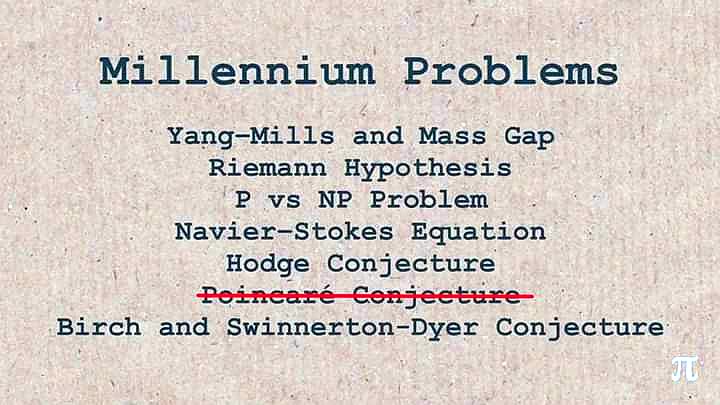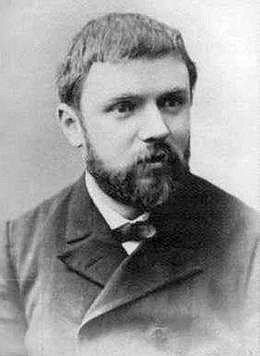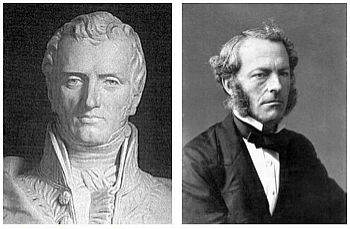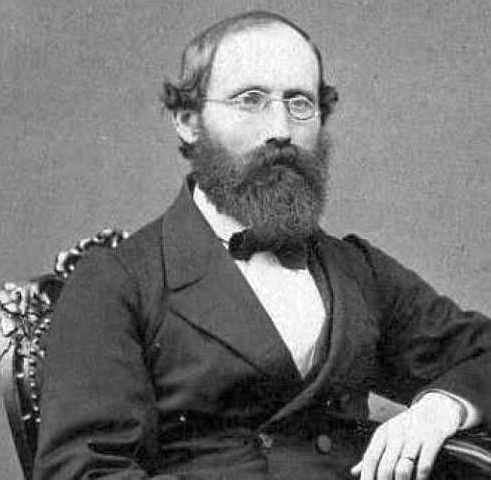Ongeveer honderd jaar geleden sprak David Hilbert, een Duitse wiskundige, over zijn spijt dat er nog drieëntwintig onopgeloste wiskundige puzzels waren. Hij deed dat op het International Congress of Mathematicians.
Vandaag de dag zijn er nog maar drie onopgelost. Maar daarbij kwamen nog vier nieuwe onoplosbare problemen. Inmiddels is er daarvan weer één opgelost, maar zes hebben zich verzet tegen alle pogingen om ze op te lossen. En dat zijn:
- Het vermoeden van Poincare [opgelost in 2002],
- Het vermoeden van Birch en Swinnerton-Dyer,
- De Navier-Stokes-vergelijkingen,
- De Riemann-hypothese (de oudste en meest bekende),
- Het P vs. NP-probleem,
- Het vermoeden van Hodge,
- Het bestaans- en massakloofprobleem van Yang-Mills.
Veel experts zijn van mening dat het oplossen van deze problemen zou leiden tot buitengewone vooruitgang in de natuur- en geneeskunde, maar zeker in (nog onbekende gebieden) van de wiskunde.

Op 24 mei 2000 heeft het Clay Mathematics Institute een prijs van $ 1.000.000 aangeboden voor de oplossing van een van de zeven millenniumprijsproblemen.
Het vermoeden van Poincaré
Het vermoeden van Poincaré is een stelling over de karakterisering van de 3-bol, de hypersfeer die de eenheidsbal begrenst in een vierdimensionale ruimte. Het vermoeden luidt: elke eenvoudig verbonden, gesloten 3-verdeelstuk is homeomorf met de 3-sfeer. Dit probleem werd in 2002 opgelost door Perelman1.

Het vermoeden van Birch en Swinnerton-Dyer
Het vermoeden van Birch en Swinnerton-Dyer beschrijft de reeks rationele oplossingen voor vergelijkingen die een elliptische curve definiëren. Het is een open probleem op het gebied van getaltheorie en wordt algemeen erkend als een van de meest uitdagende wiskundige problemen.
Het is genoemd naar de wiskundigen Bryan John Birch en Peter Swinnerton-Dyer, die het vermoeden in de eerste helft van de jaren zestig ontwikkelden met behulp van machinale berekeningen.

De Navier-Stokes-vergelijkingen
De Navier-Stokes-vergelijkingen zijn bepaalde partiële differentiaalvergelijkingen die de beweging van stroperige vloeibare substanties beschrijven, genoemd naar de Franse ingenieur en natuurkundige Claude-Louis Navier en de Anglo-Ierse natuurkundige en wiskundige George Gabriel Stokes.
Ze zijn ontwikkeld gedurende tientallen jaren van geleidelijke opbouw van de theorieën, van 1822 (Navier) tot 1842-1850 (Stokes). De Navier-Stokes-vergelijkingen drukken wiskundig het behoud van momentum en het behoud van massa uit voor Newtoniaanse vloeistoffen.

De Riemann-hypothese
De Riemann-hypothese is een vermoeden dat de Riemann-zetafunctie alleen nullen heeft bij de negatieve even gehele getallen en complexe getallen met reëel deel 1/2. Velen beschouwen het als het belangrijkste onopgeloste probleem in de zuivere wiskunde. Het is van groot belang in de getaltheorie omdat het resultaten over de verdeling van priemgetallen impliceert. Het werd voorgesteld door Bernhard Riemann (1859), naar wie het is vernoemd.

Het P versus NP-probleem
Het P versus NP-probleem is een groot onopgelost probleem in de informatica. Het vraagt of elk probleem waarvan de oplossing snel kan worden geverifieerd, ook snel kan worden opgelost. De informele term snel die hier wordt gebruikt, betekent het bestaan van een algoritme dat de taak oplost die in polynoomtijd2 wordt uitgevoerd, zodat de tijd om de taak te voltooien varieert als een polynoomfunctie van de grootte van de invoer voor het algoritme (in tegenstelling tot bijvoorbeeld exponentiële tijd).
Het vermoeden van Hodge
Het vermoeden van Hodge is een belangrijk onopgelost probleem in de algebraïsche meetkunde en complexe meetkunde dat de algebraïsche topologie van een niet-singuliere complexe algebraïsche variëteit relateert aan zijn sub variëteiten.
Of, in eenvoudige bewoordingen, het vermoeden van Hodge stelt dat de basis topologische informatie, zoals het aantal gaten in bepaalde geometrische ruimten, complexe algebraïsche variaties, kan worden begrepen door de mogelijke mooie vormen binnen die ruimten te bestuderen, die eruitzien als nul sets van polynoomvergelijkingen. De laatste objecten kunnen worden bestudeerd met behulp van algebra en de calculus van analytische functies, en dit stelt iemand in staat om indirect de brede vorm en structuur te begrijpen van vaak hoger-dimensionale ruimtes die anders niet gemakkelijk kunnen worden gevisualiseerd.
Het bestaans- en massakloofprobleem van Yang-Mills
Het bestaans- en massakloofprobleem van Yang-Mills is een onopgelost probleem in de natuur- en wiskunde. Het probleem is als volgt geformuleerd: bewijs dat voor elke compacte eenvoudige ijkgroep G een niet-triviale kwantumtheorie van Yang-Mills bestaat op R4 en een massakloof Δ > 0 heeft. Waarbij R4 de Euclidische 4-ruimte is en de massakloof Δ de massa is van het minst massieve deeltje dat door de theorie wordt voorspeld.
1 Grigori Yakovlevich Perelman werd geboren op 13 juni 1966 en is een Russische wiskundige die bekend staat om zijn bijdragen op het gebied van geometrische analyse, Riemann-meetkunde en geometrische topologie.
Op 22 december 2006 erkende het wetenschappelijke tijdschrift Science Perelman’s bewijs van het vermoeden van Poincaré als de wetenschappelijke “Doorbraak van het jaar“.
2 Het uitvoeren van een algoritme kan enige rekentijd in beslag nemen. Het hangt vooral af van hoe complex het algoritme is. Computerwetenschappers hebben een manier gevonden om het algoritme te classificeren op basis van het gedrag van het aantal bewerkingen dat het moet uitvoeren (meer bewerkingen nemen natuurlijk meer tijd in beslag). Een van die klassen vertoont polynomiale tijdcomplexiteit. Operationele complexiteit is evenredig met nc, terwijl n de invoergrootte is en c een constante is. Het is duidelijk dat de naam komt vanwege nc, wat een polynoom is.